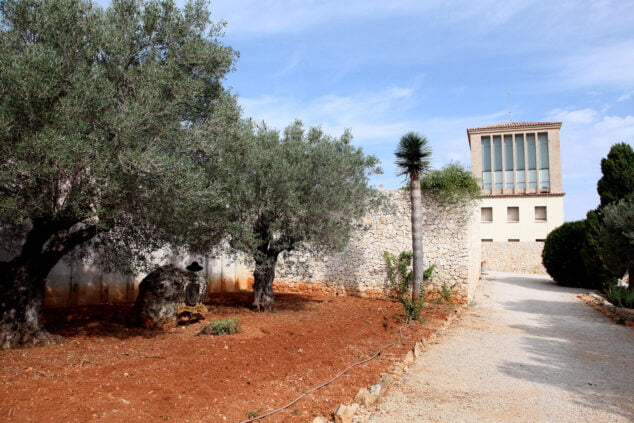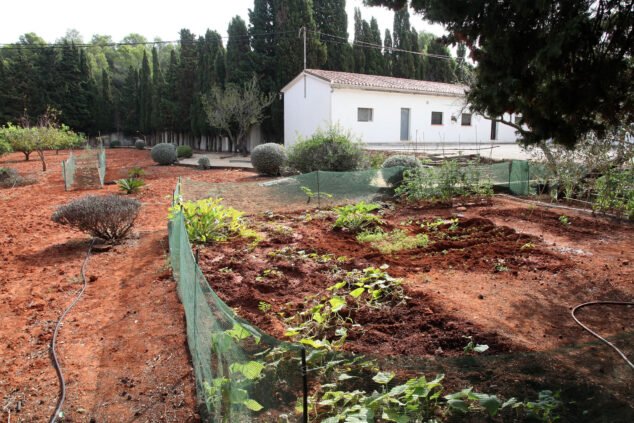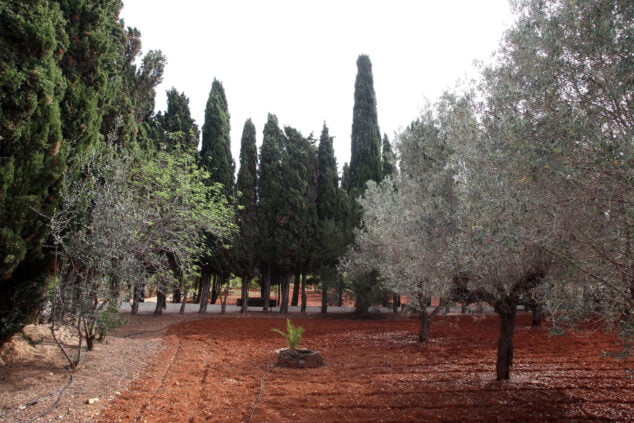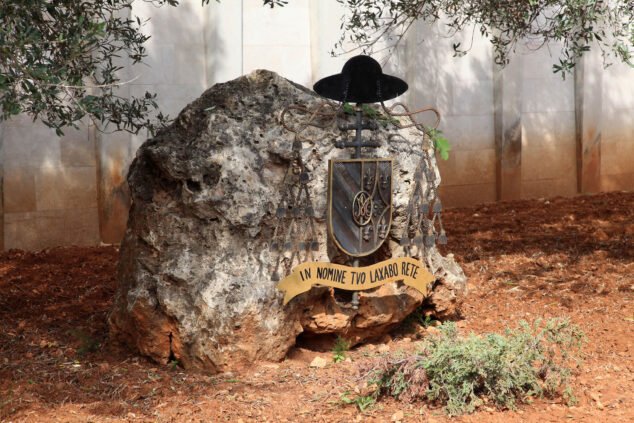El Sanctuary of the Mare de Déu dels Àngels o Monestir of La Plana, as it is also known, is a place of spirituality dating from the XNUMXth century, with a long history of reconstruction and remodeling.
Next you have an index with all the points that we are going to deal with.
- 1.
- 2.
- 2.1.
- 3.
- 4.
- 4.1.
- 4.2.
- 4.3.
- 5.
Where is it and how to get there
In the area of La Plana or Les Planes, the high plain above the sea that forms part of the end of the Montgó, just before ending at the Cape San Antonio. Precisely because of its proximity to this cape, a geostrategic point in navigation, the monastery was the object of permanent attacks by Berber pirates.
It is accessed from the road from Xàbia to Dénia, by a branch that leads to the cape. Here you have a map to get there.
History
This building has gone through many phases: first it was a hermitage, then a monastery and finally it was transformed into a hermitage and a monastery.
In the Middle Ages, it was common for religious to look for quiet and secluded places to gather and meet with God. Francesc Massanet, Jaume d'Olentori and Jaume Joan Ivanyes were commissioned to Pope Gregory XI, to request authorization for the construction of the monastery. In 1374, the Pope gave his consent and designated a place to build it, where later the hermitage of Our Lady of the Angels was built. He also gave them income for their maintenance.
The monastery was settled on the land donated by D. Alfonso de Aragón, Count of Dénia, son of the Infante D. Pedro, Duke of Gandía. Thus the order of the Jerónimos arrived in Xàbia, and the monastery with its hermitage was built, which was part of the "hermitages of the conquest", along with others located in Dénia such as Santa Lucía, Santa Paula or Sant Joan. It was a simple construction that was finished in a year, in keeping with the friars' spirit of poverty.
They were a total of twelve hermits of San Jerónimo, who before congregating, lived in them Coves Santes, on the cliff walls of Cabo de San Antonio.
Looting and destruction
This quote taken from "La Plana, terra del Llebeig", by Ferran Zurriaga i Agustí, summarizes very well the trajectory of this building:
"Hermitages were built by certain devout hermits to the devotion of Saint Geronimo, who from there began the religion that of this name shines so much in Spain, and they carved a monastery in it as we will see at length in the books that follow. He let the fury of the Barbary corsairs grow old, because they attacked him shortly after they gave him a hand, and the friars had to abandon him and go to live in another more Mediterranean one that they called San Gerónimo de Cotalba, which was carved out by the royal Duke of Gandia D Alonso de Aragón, count of Denia and Lord of all that place ... "
In 1386 according to some sources, in 1388 according to others, the monastery was looted by pirates from Bejaia (Algeria), who dismantled it, took eight monks and killed the prior. Three religious escaped, and continued their life of penance in the surroundings of the monastery.
In 1392 the captive religious were rescued by the Duke of Gandía, Don Alfonso, who relocated them to Cotalba, near that city. Another monastery was founded there and that of Xàbia was abandoned. For three centuries the monastery remained in ruins, until in 1760 two religious built a hermitage on the remains of the chapel, which presided over the canvas of Our Lady of the Angels. A canvas found by some hunters hidden in the trunk of a tree.
The hermitage was rebuilt in 1857 and 1946, keeping its original characteristics. Until in the year 1964, in which it was rebuilt to raise the current Sanctuary of the Mare de Déu dels Àngels, all the remains of the old 1994th century monastery were finished. In XNUMX, another deep remodeling takes place again.
The original characteristics of the building were its semicircular arches, the double-sloped wooden roof, concrete wall with boards and exterior buttresses, without ornamentation. It conserved a very simple Gothic door that gave access to the atrium, and inside the Gothic-pointed shield of its protector, the Royal Duke of Gandía. In 1962, a new restoration of the monastery began, according to the project of the architect José Manuel González Valcárcel, which was finished in 1964 and was classified as "unfortunate" because what little remained of the medieval monastery and the simple charm of the hermitage were destroyed. In 1999 the facilities were expanded.
Curiosities
In the XNUMXth century, a miracle happened in the surroundings of the Monastery of La Plana: it is said that a hunter, chasing a rabbit, found a canvas dedicated to the Virgin of the Angels. In the place of the discovery a chapel was built to venerate the canvas.
El Passet del Frare It is a place that is on the way down from La Plana to the Cova Tallada, and contains a legend about the destruction of the monastery (again, we quote Ferran Zurriaga i Agustí in "La Plana, terra del Llebeig"):
"Els moros s'emportaven els frares to anchor them to the Cova 'Tallà' and one d'ells is good for the coixo and to arrive at the lloc que diguem del Passet del Frare, a dels darrers moros el volgué ajudar, i ell li He is going to hit a leg and he is going to escape. Say that the cold is going to threaten in the coves that hi has lowered the lamp and for there it is diuen: the Coves Santes. Als frares se'ls emportaren to l'Alger. "
What to see and why visit
El Monestir de la Plana is in the middle of the hiking route that connects the Torre del Gerro (Dénia) and the port of Jávea. It will serve as a resting point in the shade and as a place where you can discover this heritage nestled in nature. The visit to the monastery is free.
Current uses
Since 1999, the Diocesan House of Spirituality of Our Lady of the Angels has been located there, which has the care and work of a community of Daughters of Saint Mary of the Heart of Jesus. At present, the Monastery is cared for by six sisters and each year they prepare the feast of the Virgin of the Angels (August 2) or La Plana Festivities.
Mass schedule
The chapel of the Monastery is open daily and a mass is celebrated from Monday to Friday at 9:00 a.m. and on Sundays at 10:00 a.m.
Contact
- Monastery contact phone: 96.579.00.67
- Email: javea-es@hsmcj.org
- Website: http://www.hsmcj.org/javea.html








































In the 40s, in the 50s and I don't know if in the 60s, in the hermitage of La Plana there was a hermit named Pere, Uncle Pere. He watched and. he took care of the hermitage and at noon he rang the bell, so that all the planeros would know, because then, in many cases, this was the only way. He didn't have a watch either, but he would stand in the center of the patio, plant his cane, and by the shadow cast on the ground he knew it was already noon; he was not wrong. And then, in the little houses of La Plana, there was a break from chores to pray the Angelus. All the children, when we went to the hermitage, we enjoyed ringing the bell and if you were very young and could not reach the rope, Uncle Pere would lift you up; and when it sounded without a beat after hours, the planeros knew that there was a child in the hermitage. Uncle Pere was a very endearing old man and I remember him fondly, so I ask that we stop at work and offer him an Our Father, in memory of the many prayers that he led with his ringing of the bell.
What a misspelling… “In the Middle Ages, it was common for religious to look for quiet and secluded places to gather and meet God. "
God!
I play something that you do not answer me.
Thank you very much Teresa for this great report.